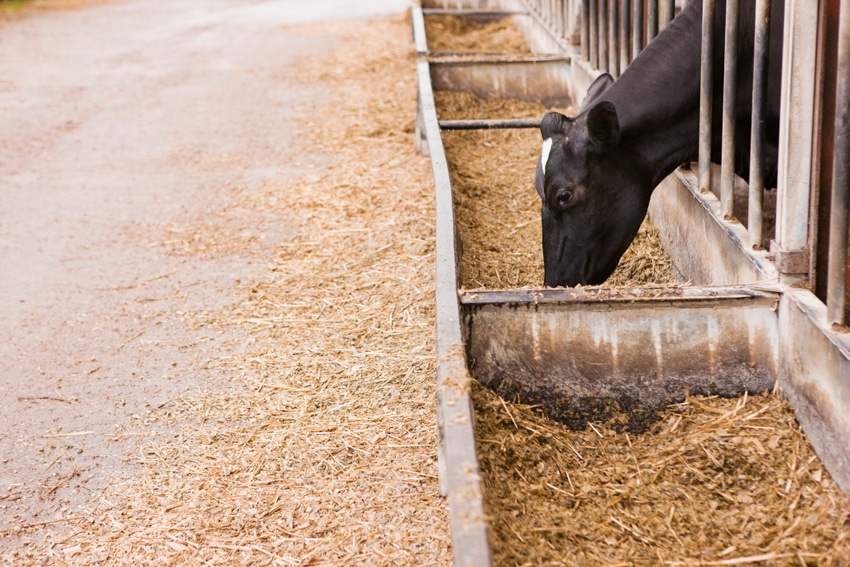Different compounds can reduce methane generated in cow’s gut.
October 26, 2017

Two researchers in the The Ohio State University College of Food, Agricultural & Environmental Sciences (CFAES) are studying how to cut methane gas produced by cows and reduce the phosphorus and nitrogen that end up in their manure — and, potentially, waterways.
Zhongtang Yu, a molecular biologist in CFAES, is working to reduce the amount of methane cattle give off by improving their digestion.
Another CFAES researcher, Chanhee Lee, an assistant professor of animal sciences, is focusing on reducing cow waste — both solids and gases. In his studies, Lee tests the effectiveness of adding chemical or biological substances to cow feed to reduce the methane they produce. He also puts additives in manure to lessen the nitrogen and phosphorus in it, thus reducing the odds of those compounds seeping into surface water.
Reducing the methane gas cattle generate not only cuts greenhouse gas emissions but potentially allows more of the feed cattle consume to be directed to their body and production. That can lead to larger, stronger cows and steers, more milk and beef, Yu said.
“Methane is bad because not only is it a greenhouse gas, but it’s a waste of feed,” Yu said.
Between 4% and 12% of the feed cattle eat is wasted through the methane gas they produce, he noted.
Yu’s current research examines how natural compounds can reduce the number of protozoa in a cow’s stomach, thus decreasing the amount of methane and nitrogen a cow expels. Any protein cattle eat that’s not used by their bodies comes out in their urine and manure in the form of nitrogen. Almost half the nitrogen in their urine and manure turns into ammonia gas, a toxic, potentially explosive gas, although not a greenhouse gas.
Different compounds can reduce the methane generated in a cow’s gut. Antibiotics are among them, but consumers sometimes steer away from buying beef that’s been given antibiotics, so Yu opted for testing compounds from natural sources. He’s found that essential oils, including garlic, rosemary and oregano oils, as well as saponins and tannins, are effective in reducing the amount of methane cattle give off in their gas and burps. Saponins are compounds found in some vegetables, beans and herbs. Tannins are bitter-tasting organic substances derived from some plants.
The essential oils, saponins and tannins reduce methane production by decreasing the numbers and activity of protozoa and methane-producing microorganisms in cattle’s guts. The protozoa don’t produce methane, but they help the methane producers that do, microorganisms called methanogens.
Yu targets the protozoa in a cow’s stomach because they cause the cow to not only produce more methane but release more nitrogen into their manure.
In his research, Yu’s graduate and undergraduate students take samples from the stomachs of cows and bringing them into the lab.
In the lab, the samples are combined with essential oils, saponins and tannins to see the effect on the protozoa and how much methane is produced. Yu’s lab has found that combinations of a few compounds, substances or both are more effective than individual compounds in reducing methane emission.
Cutting nitrogen, phosphorous
Meanwhile, Lee is studying the effect of giving cows 3-nitrooxypropanol, a white powder that can be mixed in with their feed. So far, the additive has been shown to cut methane production by up to 20%, depending on the amount they’re given.
Further studies are needed to determine that 3-nitrooxypropanol does not reduce the cattle’s production ability or have any undesirable side effects, he said.
In testing the effectiveness of 3-nitrooxypropanol, a group of cows, each housed in individual stalls, is given feed with or without the compound. Then their gas is measured.
Not only does Lee’s research aim to reduce the methane gas cows expel, but also to cut the nitrogen and phosphorus excreted in their manure. He studies whether the amount of protein and phosphorus in the nutrition guidelines for beef and dairy cattle can be reduced without jeopardizing the nutrition and strength of the cow.
Some farmers feed their animals more phosphorus than the requirements call for in hopes of boosting the cows’ production levels. However, he said, this is happening less and less.
The risk of giving cows more phosphorous or other nutrients is that the excess lands in their manure and urine, Lee said. Even after that happens, there’s an opportunity to reduce the environmental effects of that waste. Lee is testing whether a chemical or biological additive put in cow manure can change the decomposition of the manure so that it gives off less methane gas.
Also, he is testing whether a different additive can limit the amount of nitrogen in the manure that turns into ammonia gas as the manure decomposes. Reducing the nitrogen losses from manure can also improve the quality of the manure as a fertilizer.
“We want to reduce the environmental impact of cow’s waste, but we also want to improve the cow’s ability to produce,” Lee said. “We are going to have significant worldwide population growth, and we need to feed all those people.”
You May Also Like

.png?width=300&auto=webp&quality=80&disable=upscale)

